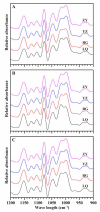Effects of Variety and Growing Location on Physicochemical Properties of Starch from Sweet Potato Root Tuber
- PMID: 34885720
- PMCID: PMC8659240
- DOI: 10.3390/molecules26237137
Effects of Variety and Growing Location on Physicochemical Properties of Starch from Sweet Potato Root Tuber
Abstract
Three sweet potato varieties with purple-, yellow-, and white-fleshed root tubers were planted in four growing locations. Starches were isolated from their root tubers, their physicochemical properties (size, iodine absorption, amylose content, crystalline structure, ordered degree, lamellar thickness, swelling power, water solubility, and pasting, thermal and digestion properties) were determined to investigate the effects of variety and growing location on starch properties in sweet potato. The results showed that granule size (D[4,3]) ranged from 12.1 to 18.2 μm, the iodine absorption parameters varied from 0.260 to 0.361 for OD620, from 0.243 to 0.326 for OD680 and from 1.128 to 1.252 for OD620/550, and amylose content varied from 16.4% to 21.2% among starches from three varieties and four growing locations. Starches exhibited C-type X-ray diffraction patterns, and had ordered degrees from 0.634 to 0.726 and lamellar thicknesses from 9.72 to 10.21 nm. Starches had significantly different swelling powers, water solubilities, pasting viscosities, and thermal properties. Native starches had rapidly digestible starch (RDS) from 2.2% to 10.9% and resistant starch (RS) from 58.2% to 89.1%, and gelatinized starches had RDS from 70.5% to 81.4% and RS from 10.8% to 23.3%. Two-way ANOVA analysis showed that starch physicochemical properties were affected significantly by variety, growing location, and their interaction in sweet potato.
Keywords: growing location; physicochemical properties; starch; sweet potato; variety.
Conflict of interest statement
The authors declare no conflict of interest.
Figures








Similar articles
-
Sizes, Components, Crystalline Structure, and Thermal Properties of Starches from Sweet Potato Varieties Originating from Different Countries.Molecules. 2022 Mar 15;27(6):1905. doi: 10.3390/molecules27061905. Molecules. 2022. PMID: 35335271 Free PMC article.
-
Non-Traditional Starches, Their Properties, and Applications.Foods. 2023 Oct 16;12(20):3794. doi: 10.3390/foods12203794. Foods. 2023. PMID: 37893687 Free PMC article. Review.
-
Effects of nitrogen level on structural and functional properties of starches from different colored-fleshed root tubers of sweet potato.Int J Biol Macromol. 2020 Dec 1;164:3235-3242. doi: 10.1016/j.ijbiomac.2020.08.199. Epub 2020 Aug 27. Int J Biol Macromol. 2020. PMID: 32861781
-
Effects of Different Isolation Media on Structural and Functional Properties of Starches from Root Tubers of Purple, Yellow and White Sweet Potatoes.Molecules. 2018 Aug 24;23(9):2135. doi: 10.3390/molecules23092135. Molecules. 2018. PMID: 30149569 Free PMC article.
-
Resistant starch from sweet potatoes: Recent advancements and applications in the food sector.Int J Biol Macromol. 2023 Jan 15;225:13-26. doi: 10.1016/j.ijbiomac.2022.12.002. Epub 2022 Dec 5. Int J Biol Macromol. 2023. PMID: 36481330 Review.
Cited by
-
Effect of Ecotype and Starch Isolation Methods on the Physicochemical, Functional, and Structural Properties of Ethiopian Potato (Plectranthus edulis) Starch.Molecules. 2023 Oct 25;28(21):7260. doi: 10.3390/molecules28217260. Molecules. 2023. PMID: 37959680 Free PMC article.
-
Sizes, Components, Crystalline Structure, and Thermal Properties of Starches from Sweet Potato Varieties Originating from Different Countries.Molecules. 2022 Mar 15;27(6):1905. doi: 10.3390/molecules27061905. Molecules. 2022. PMID: 35335271 Free PMC article.
-
Physiological, anatomical and quality indexes of root tuber formation and development in chayote (Sechium edule).BMC Plant Biol. 2023 Sep 7;23(1):413. doi: 10.1186/s12870-023-04427-0. BMC Plant Biol. 2023. PMID: 37674150 Free PMC article.
-
Feature Papers in Food Chemistry.Molecules. 2022 Dec 7;27(24):8638. doi: 10.3390/molecules27248638. Molecules. 2022. PMID: 36557772 Free PMC article.
-
Non-Traditional Starches, Their Properties, and Applications.Foods. 2023 Oct 16;12(20):3794. doi: 10.3390/foods12203794. Foods. 2023. PMID: 37893687 Free PMC article. Review.
References
-
- FAOSTAT. [(accessed on 24 October 2021)]. Available online: http://www.fao.org/faostat/en/#data.
-
- Zhu F., Wang S. Physicochemical properties, molecular structure, and uses of sweetpotato starch. Trends Food Sci. Technol. 2014;36:68–78. doi: 10.1016/j.tifs.2014.01.008. - DOI
-
- Truong V.D., Avula R.Y., Pecota K.V., Yencho G.C. Sweetpotato production, processing, and nutritional quality. In: Siddiq M., Uebersax M.A., editors. Handbook of Vegetables and Vegetable Processing. John Wiley & Sons Ltd.; Hoboken, NJ, USA: 2018. pp. 811–838.
MeSH terms
Substances
Grants and funding
LinkOut - more resources
Full Text Sources

